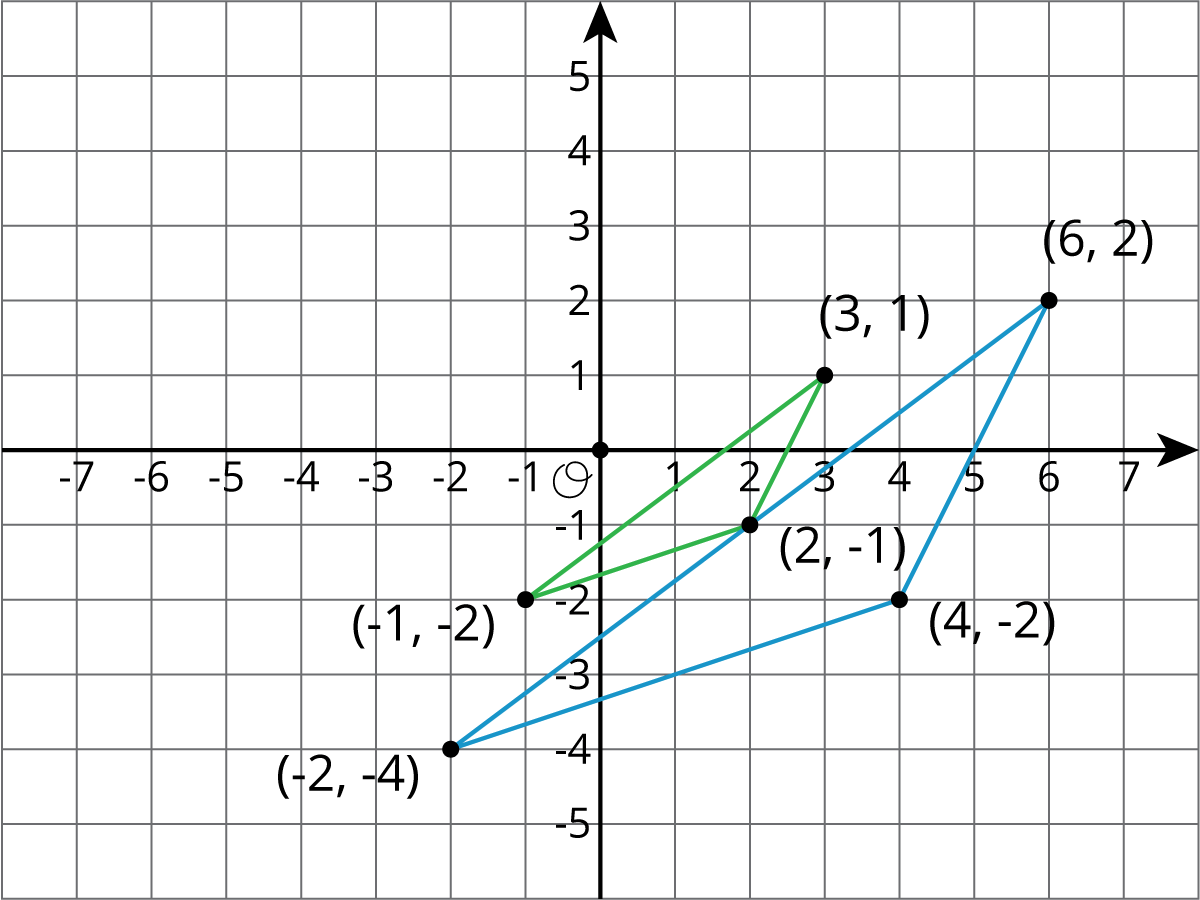Lesson 4
Dilations on a Square Grid
4.1: Estimating a Scale Factor (5 minutes)
Warm-up
In this warm-up, students estimate a scale factor based on a picture showing the center of the dilation, a point, and its image under the dilation.
Launch
Tell students they will estimate the scale factor for a dilation. Clarify that “estimate” doesn’t mean “guess.” Encourage students to use any tools available to make a precise estimate. Provide access to geometry toolkits.
Student Facing

Point \(C\) is the dilation of point \(B\) with center of dilation \(A\) and scale factor \(s\). Estimate \(s\). Be prepared to explain your reasoning.
Student Response
For access, consult one of our IM Certified Partners.
Activity Synthesis
Check with students to find what methods they used to compare distances. Likely methods include using a ruler and division or using an index card and marking off multiples of the distance from \(A\) to \(B\).
Ask students:
- “Is the scale factor greater than 1?” (Yes.) “How do you know?” (the point \(C\) is further from \(A\) than \(B\))
- “Is the scale factor greater than 2?” (Yes.) “How do you know?” (the distance from \(C\) to \(A\) is more than twice the distance from \(B\) to \(A\))
- “Is the scale factor greater than 3?” (No.) “How do you know?” (The distance from \(C\) to \(A\) is less than 3 times the distance from \(B\) to \(A\).)
- “Is the scale factor greater or less than 2.5?” (It is less.) “How do you know?” (The distance from \(C\) to \(A\) is less than 2.5 times the distance from \(B\) to \(A\).)
4.2: Dilations on a Grid (10 minutes)
Activity
In previous lessons, students perform dilations on a circular grid and with no grid. In this activity, they perform dilations on a square grid. A square grid is particularly helpful if the center of dilation and the points being dilated are grid points. When the extra structure of coordinates is added, as in the next activity, the grid provides an extremely convenient tool for naming points and describing the effects of dilations using coordinates. As in previous lessons, students will again see that scale factors greater than 1 produce larger copies while scale factors less than 1 produce smaller copies.
Monitor for how students find the dilated points and the language they use to describe the process. In particular:
- using a ruler or index card to measure distances along the rays emanating from the center of dilation
- taking advantage of the grid and counting how many squares to the left or right, up or down
Launch
Provide access to geometry toolkits.
Supports accessibility for: Social-emotional skills; Conceptual processing
Student Facing
- Find the dilation of quadrilateral \(ABCD\) with center \(P\) and scale factor 2.
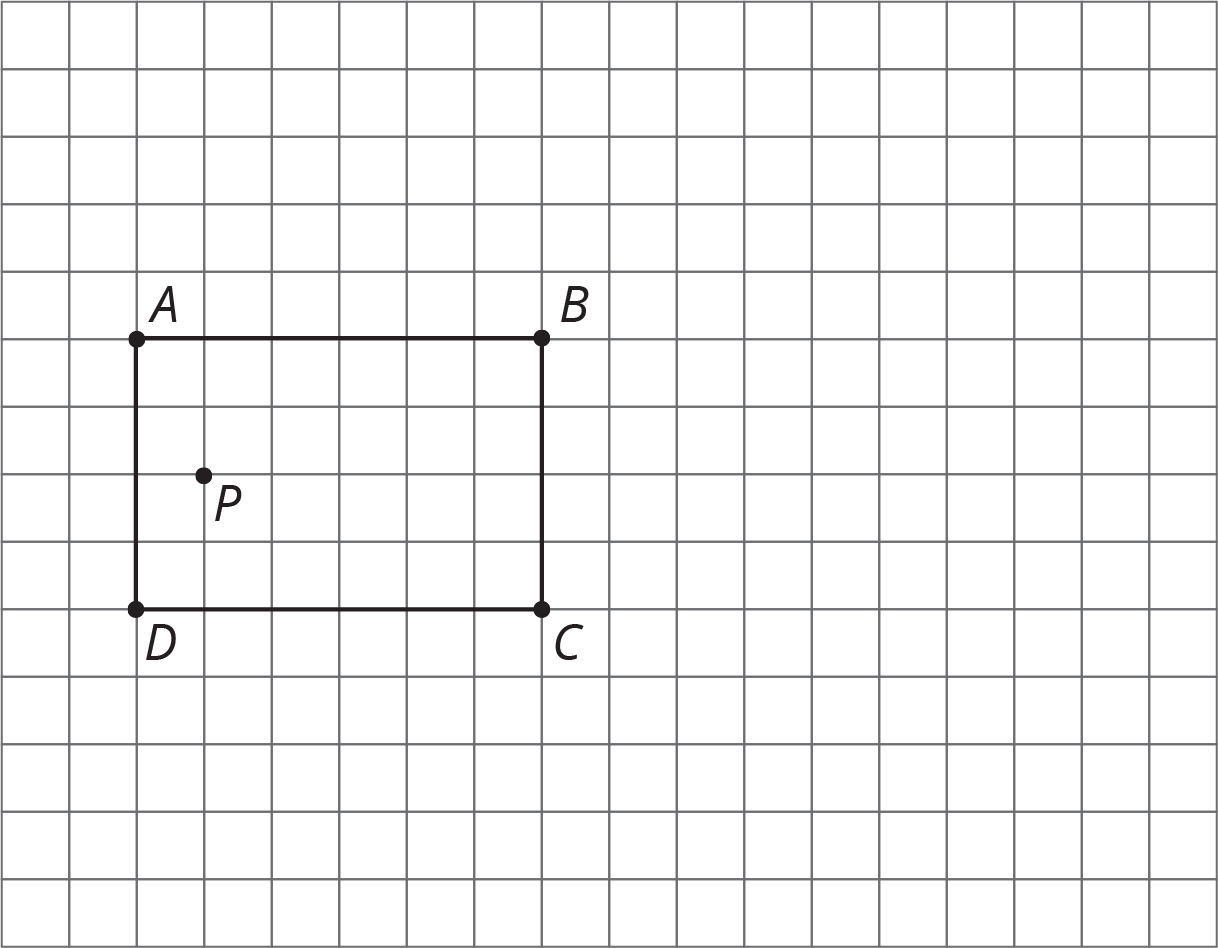
- Find the dilation of triangle \(QRS\) with center \(T\) and scale factor 2.
- Find the dilation of triangle \(QRS\) with center \(T\) and scale factor \(\frac{1}{2}\).
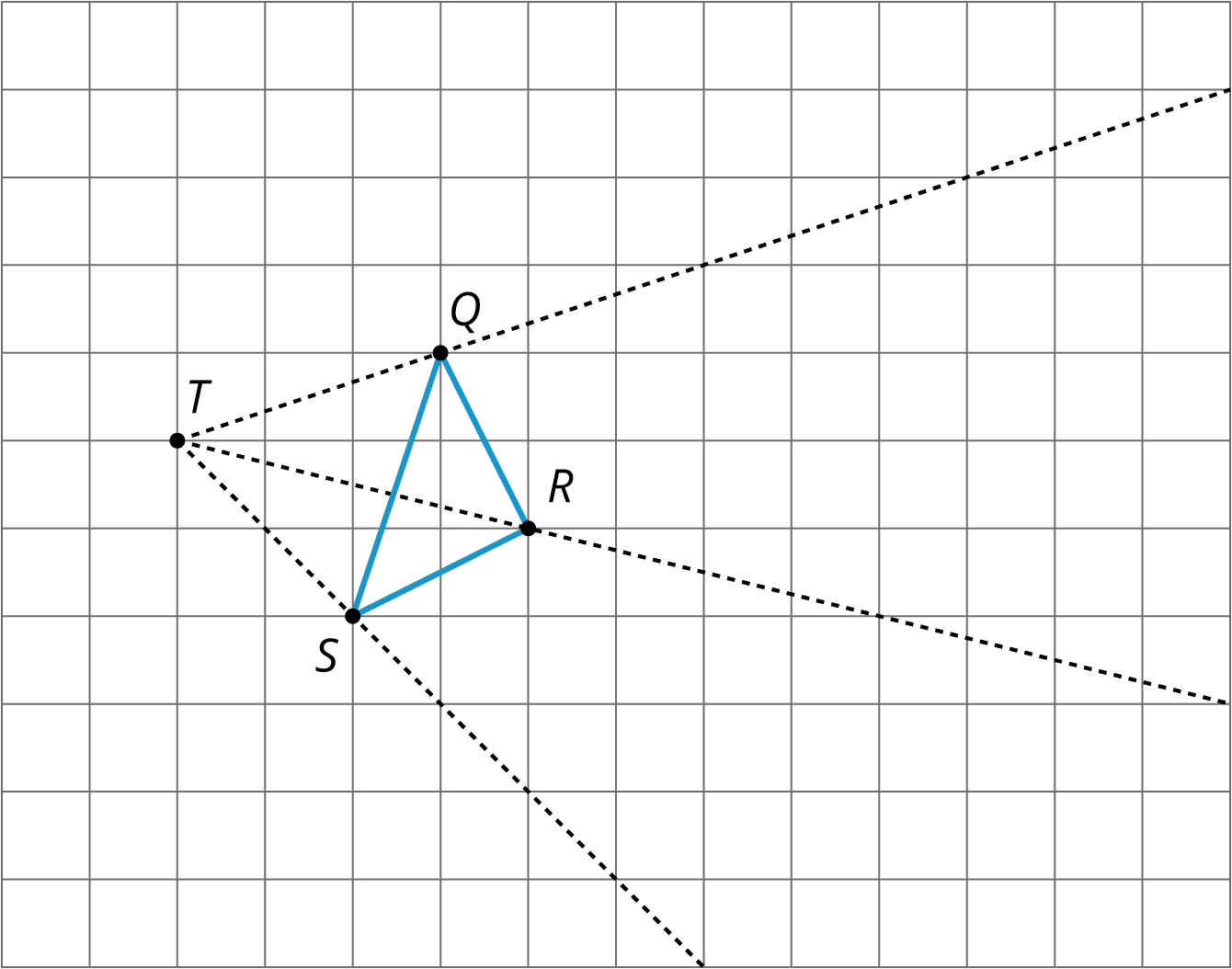
Student Response
For access, consult one of our IM Certified Partners.
Activity Synthesis
Select students to show how they found the dilations. First, select any students who used the same methods as when there was no grid, followed by students who noticed they could use the structure of the grid. Draw connections between these two methods—show that when you measure with a ruler or by making markings on an index card, the dilated point ends up in the same place as by reasoning about the grid.
Expect students to use expressions like “moving over two and up one.” These measurements can be multiplied by the scale factor in order to find the location of the dilated point.
Tell students that moving forward they will do work on the grid with the added structure of coordinates. The method of performing dilations is the same. The only change is that the coordinates give a concise way to name points.
4.3: Card Sort: Matching Dilations on a Coordinate Grid (15 minutes)
Activity
In the previous task, students worked on a square grid without coordinates. This activity adds the structure of coordinates and this extra structure plays a key role, allowing students to name points. Students match figures with their dilated images, using coordinates to describe the center of dilation and the vertices. The same strategies that were used previously in dilating images,on a circular grid and with no grid, will be useful here.
Monitor for students who identify that the dilation of a circle is a circle and similarly for triangles and quadrilaterals. This will help them eliminate certain possibilities for each match. Because there is one card that does not match, students should verify the other matches by performing the dilations. Once the card without a match has been identified, reasoning based on eliminating possibilities (without performing the dilations) is correct. Monitor for students who systematically perform the dilations to help identify a match versus those who reason by structure and elimination of possibilities. Invite both to share during the discussion.
Launch
Students practice matching an original figure and dilation description to information about the dilated images using the coordinate plane. Distribute one set (numbers 1 through 6 and letters A through F) of cards to each student.
There is one extra option that does not have a match. Students should draw the dilated image for that option themselves.
Supports accessibility for: Conceptual processing; Organization
Design Principle(s): Support sense-making; Maximize meta-awareness
Student Facing
Your teacher will give you some cards. Each of Cards 1 through 6 shows a figure in the coordinate plane and describes a dilation.
Each of Cards A through E describes the image of the dilation for one of the numbered cards.
Match number cards with letter cards. One of the number cards will not have a match. For this card, you’ll need to draw an image.
Student Response
For access, consult one of our IM Certified Partners.
Student Facing
Are you ready for more?
The image of a circle under dilation is a circle when the center of the dilation is the center of the circle. What happens if the center of dilation is a point on the circle? Using center of dilation \((0,0)\) and scale factor 1.5, dilate the circle shown on the diagram. This diagram shows some points to try dilating.

Student Response
For access, consult one of our IM Certified Partners.
Anticipated Misconceptions
If students are having trouble finding accurate matches, suggest that they identify the center of dilation and consider if the dilation will result in a smaller or larger sized image.
Activity Synthesis
Share the correct answers and invite selected students to share the strategies they used to solve the problems. This is a matching problem, so students may not have dilated the entire image to find the correct answer among the choices. Important points to bring out include:
- A dilation maps a circle to a circle, a quadrilateral to a quadrilateral, and a triangle to a triangle.
- If the center of dilation for a polygon is one of the vertices, then that vertex is on the dilated polygon.
- If the scale factor is less than 1 then the dilated image is smaller than the original figure.
- If the scale factor is larger than 1 then the dilated image is larger than the original figure.
Lesson Synthesis
Lesson Synthesis
- “How do we perform dilations on a square grid?”
- “How do coordinates help describe and perform dilations?”
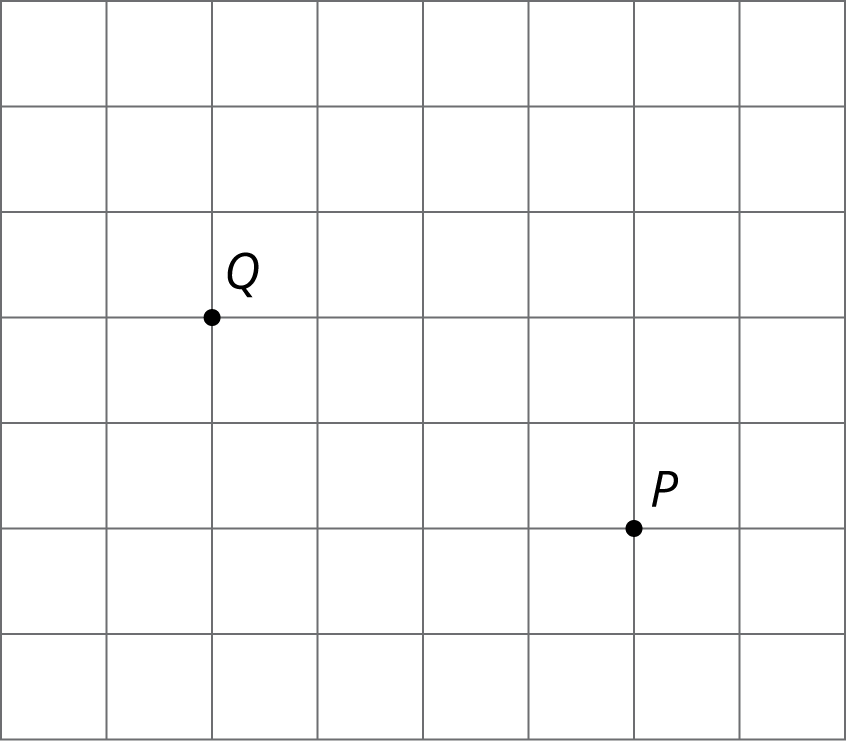
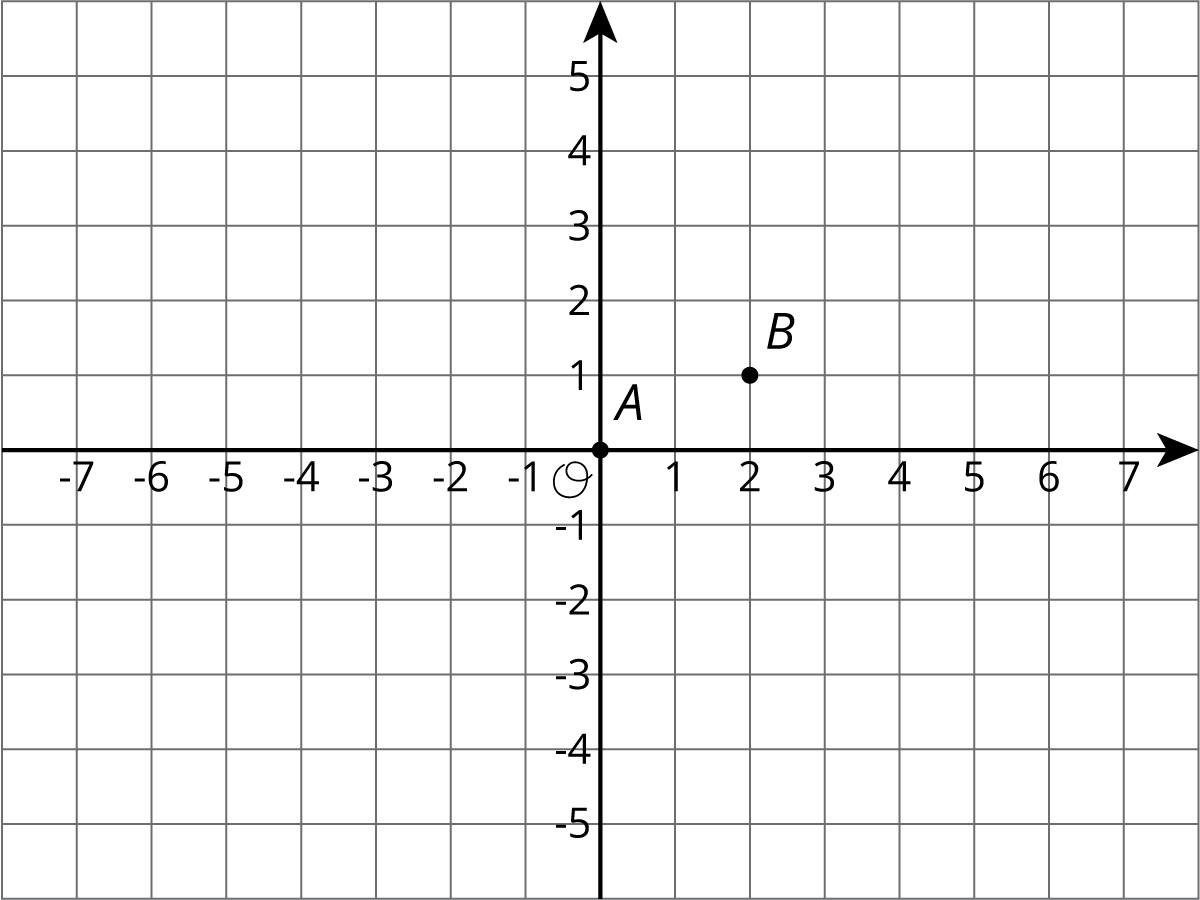
4.4: Cool-down - A Dilated Image (5 minutes)
Cool-Down
For access, consult one of our IM Certified Partners.
Student Lesson Summary
Student Facing
Square grids can be useful for showing dilations. The grid is helpful especially when the center of dilation and the point(s) being dilated lie at grid points. Rather than using a ruler to measure the distance between the points, we can count grid units.
For example, suppose we want to dilate point \(Q\) with center of dilation \(P\) and scale factor \(\frac{3}{2}\). Since \(Q\) is 4 grid squares to the left and 2 grid squares down from \(P\), the dilation will be 6 grid squares to the left and 3 grid squares down from \(P\) (can you see why?). The dilated image is marked as \(Q’\) in the picture.

Sometimes the square grid comes with coordinates. The coordinate grid gives us a convenient way to name points, and sometimes the coordinates of the image can be found with just arithmetic.
For example, to make a dilation with center \((0,0)\) and scale factor 2 of the triangle with coordinates \((\text-1, \text- 2)\), \((3,1)\), and \((2, \text- 1)\), we can just double the coordinates to get \((\text- 2, \text- 4)\), \((6,2)\), and \((4, \text- 2)\).
